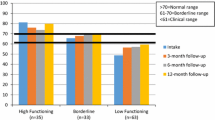Abstract
This study examined sociodemographic and clinical characteristics of treatment completers (N = 114) and non-completers (N = 136) at a child and adolescent community mental health clinic. Results indicated that children who completed treatment significantly differ from those who prematurely drop out of treatment. Non-completers presented with considerably more impairment in functioning and psychiatric symptoms, and their caregiver reported experiencing significantly more parenting stress and depressive symptoms. Results suggest that mental health treatment is not readily provided to the most difficult to reach and most at-risk youth and their families.

Similar content being viewed by others
References
Abidin, R. R. (1995). Parenting stress index (3rd ed.). Odessa, FL: Psychological Assessment Resources.
Achenbach, T. M. (1991). Manual for the child behavior checklist/4–18. Burlington, VT: University of Vermont, Department of Psychiatry.
Ambruster, P., & Kazdin, A. E. (1994). Attrition in child psychotherapy. In T. H. Ollendick & R. J. Prinz (Eds.), Advances in clinical child psychology (pp. 81–108). New York: Plenum.
Clarkin, J. F., & Levy, K. N. (2004). Influence of client variables on psychotherapy. In M. J. Lambert (Ed.), Handbook of psychotherapy and behavior change (5th ed.). New York: Wiley.
Costa, N. M., Weems, C. F., & Pina, A. (2009). Hurricane Katrina and youth anxiety: The role of perceived attachment beliefs and parenting behaviors. Journal of Anxiety Disorders, 23, 935–941.
Dalton, R., Pellerin, K., Carbone, V., Theriot, A., Thibodeaux, D., Stewart, L., et al. (2000). Treatment outcome among child psychiatric outpatients in a community mental health center. Community Mental Health Journal, 36, 195–203.
Dalton, R., Pellerin, K., Wolfe, M., Stewart, L., Thibodeaux, D., Clouatre, A., et al. (2003). Adolescent treatment outcome in a community mental health center. Community Mental Health Journal, 39, 47–62.
Derogatis, L. R., & DellaPietra, L. (1994). Psychological tests in screening for psychiatric disorders. In M. Maruish (Ed.), Psychological testing: Treatment planning and outcome assessment (pp. 22–54). Hillsdale, NJ: Lawrence Erlbaum Associates.
Derogatis, L. R., & Melisaratos, N. (1983). The brief symptom inventory: And introductory report. Psychological Medicine, 13, 595–605.
Gould, M. S., Shaffer, D., & Kaplan, D. (1985). Characteristics of dropouts from a child psychiatry clinic. Journal of the American Academy of Child Psychiatry, 24, 316–328.
Kazdin, A. E. (1990). Premature termination from treatment among children referred for antisocial behavior. Journal of Child Psychology and Psychiatry, 31, 415–425.
Kazdin, A. E., Mazurick, J. L., & Bass, D. (1993). Risk for attrition in treatment of antisocial children and families. Journal of Clinical Child Psychology, 22, 2–16.
Kazdin, A. E., Mazurick, J. L., & Siegel, T. C. (1994). Treatment outcome among children with externalizing disorder who terminate prematurely versus those who complete psychotherapy. Journal of the American Academy of Child and Adolescent Psychiatry, 33, 549–557.
Kazdin, A. E., Stolar, M. J., & Marciano, P. L. (1995). Risk factors for dropping out of treatment among white and black families. Journal of Family Psychology, 9, 402–417.
Kendall, P. C., & Sugarman, A. (1997). Attrition in the treatment of childhood anxiety disorders. Journal of Consulting and Clinical Psychology, 65, 883–888.
Larsen, D. L., Nguyen, T. D., Green, R. S., & Attkisson, C. C. (1983). Enhancing the utilization of outpatient mental health services. New York: Human Sciences Press.
McAdoo, W. G., & Roeske, N. A. (1973). A comparison of defectors and continuers in a child guidance clinic. Journal of Consulting and Clinical Psychology, 40, 328–334.
Olfson, M., Mojtabai, R., Sampson, N., Hwang, I., Druss, B., Wang, P., et al. (2009). Dropout from outpatient mental health care in the United States. Psychiatric Services, 60, 898–907.
Pekarik, G. (1985). Coping with dropouts. Professional Psychology: Research and Practice, 16, 114–123.
Pekarik, G., & Stephenson, L. A. (1988). Adult and child client differences in therapy dropout research. Journal of Clinical Child Psychology, 17, 316–321.
Pina, A. A., Silverman, W. K., Weems, C. F., Kurtines, W. M., & Goldman, M. L. (2003). A comparison of completers and noncompleters of exposure-based cognitive and behavioural treatment for phobic and anxiety disorders in youth. Journal of Consulting and Clinical Psychology, 71, 701–705.
Swift, J., Callahan, J., & Levine, J. (2009). Using clinically significant change to identify premature termination. Psychotherapy: Theory, Research, Practice, and Training, 46, 328–335.
United States Congress Office of Technology Assessment. (1991). Adolescent health. Washington, D.C.: United States Government Printing Office.
Viale-Val, G., Rosenthal, R. H., Curtiss, G., & Marohn, R. C. (1984). Dropout from adolescent psychotherapy: A preliminary study. Journal of the American Academy of Child Psychiatry, 23, 562–568.
Weems, C. F., Watts, S. E., Marsee, M. A., Taylor, L. K., Costa, N. M., Cannon, M. F., et al. (2007). The psychosocial impact of Hurricane Katrina: Contextual differences in psychological symptoms, social support, and discrimination. Behaviour Research and Therapy, 45, 2295–2306.
Weisz, J. R., Weiss, B., & Langmeyer, D. B. (1987). Giving up on child psychotherapy: Who drops out? Journal of Consulting and Clinical Psychology, 55, 916–918.
Wierzbicki, M., & Pekarik, G. (1993). A meta-analysis of psychotherapy dropout. Professional Psychology: Research and Practice, 24, 190–195.
Author information
Authors and Affiliations
Corresponding author
Rights and permissions
About this article
Cite this article
Pellerin, K.A., Costa, N.M., Weems, C.F. et al. An Examination of Treatment Completers and Non-Completers at a Child and Adolescent Community Mental Health Clinic. Community Ment Health J 46, 273–281 (2010). https://doi.org/10.1007/s10597-009-9285-5
Received:
Accepted:
Published:
Issue Date:
DOI: https://doi.org/10.1007/s10597-009-9285-5




